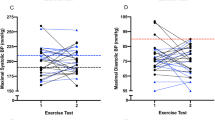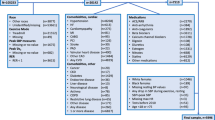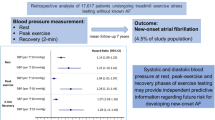Abstract
Exercise systolic blood pressure (BP) appears to be a better predictor of cardiac mortality than casual office BP. We tested whether this could be explained by exercise systolic BP being a better predictor of sustained hypertension than casual office BP. Exercise systolic BP was measured using the lightweight 3-min single stage, submaximal Dundee Step Test in 191 consecutive subjects (102 male, age 52 (s.d. 13) years) who were referred to a specialist hypertension clinic for assessment. Exercise systolic BP was compared with office BP and daytime ambulatory BP (ABP). Sustained hypertension was defined as a mean daytime systolic and/or diastolic ABP of ⩾140/90 mm Hg. Receiver operating characteristic (ROC) curves of exercise systolic BP and office BP in predicting sustained hypertension were compared. The positive predictive value of office diastolic BP ⩾90 mm Hg and office systolic BP ⩾140 mm Hg for sustained hypertension were 64% and 67% respectively. However, exercise systolic BP ⩾180 mm Hg had a positive predictive value of 76%. Twenty-two percent (42/191) of subjects had an exercise systolic BP rise to ⩾210 mm Hg, and 93% of this group had sustained hypertension on ABP. Whilst exercise systolic BP was a better predictor of sustained hypertension using currently recommended office BP treatment thresholds, the ROC curves of these indices were not different. In a multiple regression analysis, exercise systolic BP was an independent predictor of sustained hypertension, accounting for 36% of the variance of daytime systolic ABP after adjusting for age, gender and antihypertensive drug treatment. In conclusion, exercise systolic BP was a marginally better predictor of sustained hypertension than office BP. This may partly explain why exercise systolic BP is a potent predictor of cardiac mortality.
This is a preview of subscription content, access via your institution
Access options
Subscribe to this journal
Receive 12 digital issues and online access to articles
$119.00 per year
only $9.92 per issue
Buy this article
- Purchase on Springer Link
- Instant access to full article PDF
Prices may be subject to local taxes which are calculated during checkout
Similar content being viewed by others
Author information
Authors and Affiliations
Rights and permissions
About this article
Cite this article
Lim, P., Donnan, P. & MacDonald, T. How well do office and exercise blood pressures predict sustained hypertension? A Dundee Step Test Study. J Hum Hypertens 14, 429–433 (2000). https://doi.org/10.1038/sj.jhh.1001041
Received:
Revised:
Accepted:
Published:
Issue Date:
DOI: https://doi.org/10.1038/sj.jhh.1001041



